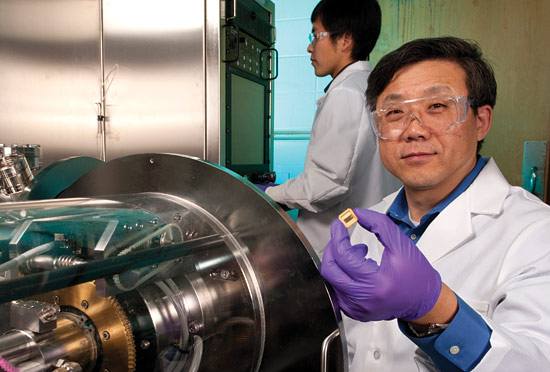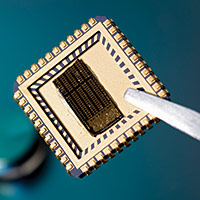
By tracey bryantOffice of Communications & Marketing

John Xiao was fascinated by magnetism as a child. "I thought it was like magic," he says. The attraction has never faded.
Today, the professor of physics and astronomy directs the Center for Spin-tronics and Biodetection (CSB) at UD, a growing research collaboration aimed at lassoing the magnet-like "spin" of electrons to encode and process data.
The new field of "spintronics" is expected to transform the electronics industry, yielding cheaper, faster, less power-hogging cell phones, computers and other devices. Xiao's interest lies in harnessing the "spin" to create new sensors so fine — in environmental monitors to medical diagnostic equipment — they can detect particles a thousand times smaller than a human cell.
UD's center, established in 2007 through the U.S. Department of Energy Experimental Program to Stimulate Competitive Research (EPSCoR), involves an interdisciplinary team of scientists from UD, as well as researchers from Brown University in Providence, R.I., and Argonne National Laboratory, one of DOE's largest research centers, located near Chicago.
In addition to Xiao, the principal investigators include professor Edmund Nowak, associate professor Branislav Nikolic and assistant professor Yi Ji in the Department of Physics and Astronomy, and James Kolodzey, the Charles Black Evans Professor of Electrical and Computer Engineering — all at UD — and Souheng Sun, professor of chemistry and engineering at Brown University. Post-doctoral researchers and graduate students from both universities also are involved.

The team has five patents in the pipeline so far, most of them demonstrating spintronics in the microwave regime, which is the UD center's innovation, Xiao says. Their prototype sensor, of particular interest to the military, can detect microwaves through the change in sensor resistance. The sensor can be made smaller than a micron (that's smaller than four one-hundred-thousandths of an inch).
"Microwaves used in communication are very weak, and our sensor is very sensitive and is able to detect the microwave phase with a circuit that is much simpler than those used in traditional approaches. As such, it is easy to build an array of sensors that can be used to image the microwaves," Xiao says. "With this technique, we are exploring medical applications such as the detection of breast cancer — that is a very exciting aspect of this research."
A major goal is to develop a biosensor, patterned much like a DNA chip, that can detect the tiny magnetic field generated by a single nano-sized particle that can then be used to label various biomolecules. Although this approach to biodetection is not new, Xiao says, he and his colleagues are working to perfect the technique, and a prototype biosensor has been developed.
"The goal is to detect as few nanoparticles as possible present," Xiao says. "We can attach DNA to the magnetic particles and 'functionalize' them, linking them, one-to-one, to a biomolecule."
The applications for more sensitive sensors are numerous, Xiao says, from increasing the early diagnosis of cancer, diabetes and other diseases, to detecting harmful viruses as part of antiterrorism programs.
As the work proceeds, each collaborator contributes a critical strength, Xiao says. Brown University researchers are functionalizing the surface of the magnetic particles and know how to attach them to the sensor and to the target biomolecule. The UD researchers are experts at understanding the underlying physics for better sensor design and signal-to-noise ratio, and the feasibility and demonstration of the technology. And colleagues at the Center for Nanoscale Materials at Argonne National Laboratory are helping to fabricate the spintronics devices.
"This is very much a team effort," Xiao says. "Scientists can do something very useful, very helpful, when working together in an interdisciplinary way."